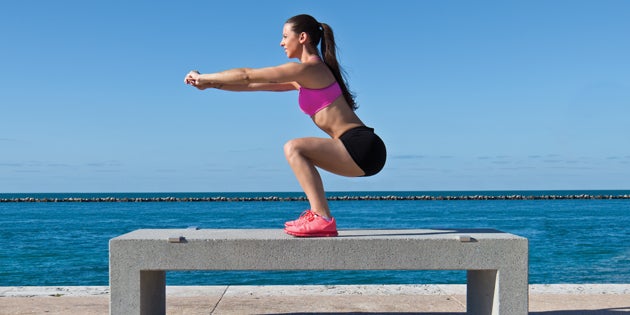Heading out the door? Read this article on the new Outside+ app available now on iOS devices for members! Download the app.

• Stand with your feet hip-width apart with your toes angled outward 5 to 15 degrees. This helps the knees stay over the toes and prevents your legs from moving inward, which could put your knees at risk.
• Your weight should be in your heels. Test it out: You should be able to wiggle your toes at both the top and the bottom of the motion.
• Keep your back straight, your shoulders drawn back and your head neutral. Maintain this position throughout the move to protect your spine.
See Also Get It Right: Kettlebell Swing
• Inhale before you start and briefly hold your breath as you descend. This increases intra-abdominal pressure to help stabilize your body and protect your spine.
• Send your hips backward first, then follow by bending your knees. This helps concentrate the weight in your heels so you don’t tip forward and lose your balance.
• Descend slowly, using perfect form and control, until the crease of your hip drops below your knees or — if you have the flexibility — until you bottom out.*
• Exhale and explode out of the bottom, driving through your heels to return to standing.
*Should you break parallel? The research says yes. Duke University conducted a study that analyzed more than 20 years of research on squats and knee health and concluded that squats do not compromise knee stability and can actually enhance it when done correctly. In addition, stopping above parallel actually produces higher shearing forces on your knees than when descending all the way down into a deep squat. The reason: When below parallel, the hamstrings counteract the force of the quads on the front, stabilizing the knees and taking the stress off the ACLs, according to the American Journal of Sports Medicine. If you have trouble dropping low, try taking a slightly wider stance to open your hips, and do hip-centric flexibility work post-training to increase your range of motion.
Squat Variations
Split squat
Smith-machine squat
One-legged squat
Sissy squat
Front squat
Back squat
Goblet squat
Dumbbell squat
Wall squat
Tip: Where you place the weight can change the emphasis: Holding a barbell on your back shifts the emphasis to your hamstrings and glutes, while holding it in a front-rack position makes it a quad killer. Having dumbbells at your sides distributes the weight more evenly throughout your feet, hitting the total leg.